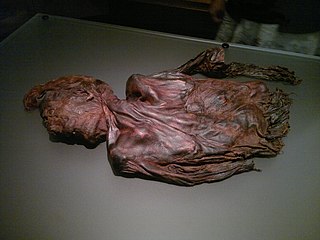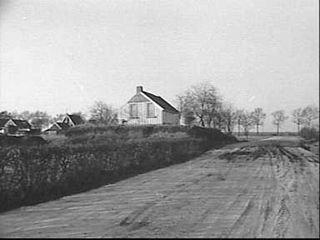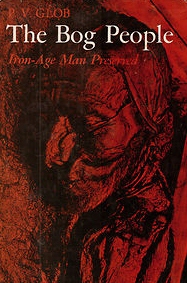
The Tollund Man is a naturally mummified corpse of a man who lived during the 5th century BCE, during the period characterised in Scandinavia as the Pre-Roman Iron Age. He was found in 1950, preserved as a bog body, near Silkeborg on the Jutland peninsula in Denmark. The man's physical features were so well preserved that he was mistaken for a recent murder victim. Twelve years before his discovery, another bog body, Elling Woman, was found in the same bog.

A bog body is a human cadaver that has been naturally mummified in a peat bog. Such bodies, sometimes known as bog people, are both geographically and chronologically widespread, having been dated to between 8000 BC and the Second World War. The unifying factor of the bog bodies is that they have been found in peat and are partially preserved; however, the actual levels of preservation vary widely from perfectly preserved to mere skeletons.

Dutch Low Saxon are Low Saxon dialects from the Low German language that are spoken in the northeastern Netherlands and are mostly, but not exclusively, written with local, unstandardised orthographies based on Standard Dutch orthography.
Tweants is a group of non-standardised Dutch Low Saxon dialects, descending from Old Saxon.

Old Croghan Man is a well-preserved Irish Iron Age bog body found in June 2003. The remains are named after Croghan Hill, north of Daingean, County Offaly, near where the body was found. The find is on display in the National Museum of Ireland in Dublin.

Clonycavan Man is the name given to a well-preserved Iron Age bog body found in Clonycavan, Ballivor, County Meath, Ireland in March 2003. The body shows signs of having been murdered. Theories around the meanings and manner of his death vary.

Yde Girl is a bog body found in the Stijfveen peat bog near the village of Yde, Netherlands. She was found on 12 May 1897 and was reputedly uncannily well-preserved when discovered, but by the time the body was turned over to the authorities two weeks later, it had been severely damaged and deteriorated. Most of her teeth and hair had been pulled from the skull. The peat-cutting tools had also been reported to have severely damaged the body.

The Grauballe Man is a bog body that was uncovered in 1952 from a peat bog near the village of Grauballe in Jutland, Denmark. The body is that of a man dating from the late 3rd century BC, during the early Germanic Iron Age. Based on the evidence of his wounds, he was most likely killed by having his throat slit. His corpse was then deposited in the bog, where his body was naturally preserved for over two millennia. His was not the only bog body to be found in the peat bogs of Jutland. Together with other notable examples, Tollund Man and the Elling Woman, Grauballe Man represents an established tradition at the time. It is commonly thought that these killings, including that of Grauballe Man, were examples of human sacrifice, possibly an important rite in Iron Age Germanic paganism.

The Girl of the Uchter Moor, also known as Moora, is the name given to a female Iron Age bog body discovered in 2000 in marshland near Uchte, Germany. The remains include vertebrae, hair and skull pieces. The studies of the body began in 2005. The radiocarbon dating performed at the University of Kiel showed that Moora had died between 764 and 515 BC. Despite common Iron Age burial practices, the body was not cremated. All the body parts are estimated to have been found except for one scapula.
The Tubantes were a Germanic tribe, living in the eastern part of the Netherlands, north of the Rhine river. They are often equated to the Tuihanti, who are known from two inscriptions found near Hadrian's Wall. The modern name Twente derives from the word Tuihanti.

The Haraldskær Woman is the name given to a bog body of a woman preserved in a bog in Jutland, Denmark, and dating from about 490 BC. Workers found the body in 1835 while excavating peat on the Haraldskær Estate. The anaerobic conditions and acids of the peat bog contributed to the body's excellent preservation. Not only was the intact skeleton found, but so were the skin and internal organs. Scientists settled disputes about the age and identity of this well-preserved body in 1977, when radiocarbon dating determined conclusively that the woman's death occurred around the 5th century BC.

Emmer-Erfscheidenveen is a hamlet in the Netherlands and it is part of the Emmen municipality in Drenthe.

Windeby I is the name given to the bog body found preserved in a peat bog near Windeby, Northern Germany, in 1952. Until recently, the body was also called the Windeby Girl, since an archaeologist believed it to be the body of a 14-year-old girl, because of its slight build. Professor Heather Gill-Robinson, a Canadian anthropologist and pathologist, used DNA testing to show the body was actually that of a sixteen-year-old boy. The body has been radiocarbon-dated to between 41 BC and 118 AD.

Osterby Man or the Osterby Head is a bog body of which only the skull and hair survived. It was discovered in 1948 by peat cutters to the southeast of Osterby, Germany. The hair is tied in a Suebian knot. The head is at the State Archaeological Museum at Gottorf Castle in Schleswig, Schleswig-Holstein.
The Borremose bodies are three bog bodies that were found in the Borremose peat bog in Himmerland, Denmark. Recovered between 1946 and 1948, the bodies of a man and two women have been dated to the Nordic Bronze Age. In 1891, the Gundestrup cauldron was found in a nearby bog.

The Drents Museum is an art and history museum in Assen, Drenthe, in the Netherlands. The museum was opened in 1854. It has a collection of prehistorical artifacts, applied art, and visual art. The museum also has temporary exhibitions. In 2023, it had 179,345 visitors.

The Bourtanger Moor was a bog in eastern parts in the Dutch provinces of Drenthe and Groningen and the bordering German districts of Bentheim and Emsland. A remaining stretch on the border between Drenthe and the districts Emsland and Betheim is now a nature reserve, the Internationaler Naturpark Bourtanger Moor-Bargerveen.

Dr. Wijnand Antonius Bernardus van der Sanden is a Dutch archaeologist and prehistorian.

The Bog People: Iron-Age Man Preserved is an archaeological study of the bog bodies of Northern Europe written by the Danish archaeologist P.V. Glob. First published in 1965 by Gyldendal under the Danish title of Mosefolket: Jernalderens Mennesker bevaret i 2000 År, it was translated into English by the English archaeologist Rupert Bruce-Mitford and published by Faber and Faber in 1969. In 1966 it was translated into German by Thyra Dohrenburg and published by Winkler Verlag Munich under the title Die Schläfer im Moor.

![The remains of the Weerdinge Men shortly after discovery in 1904 prepared for air drying (photographer Geert Jannes Landweer [nl]) Weerdinge-men 1904.jpg](http://upload.wikimedia.org/wikipedia/commons/thumb/c/c6/Weerdinge-men_1904.jpg/220px-Weerdinge-men_1904.jpg)















